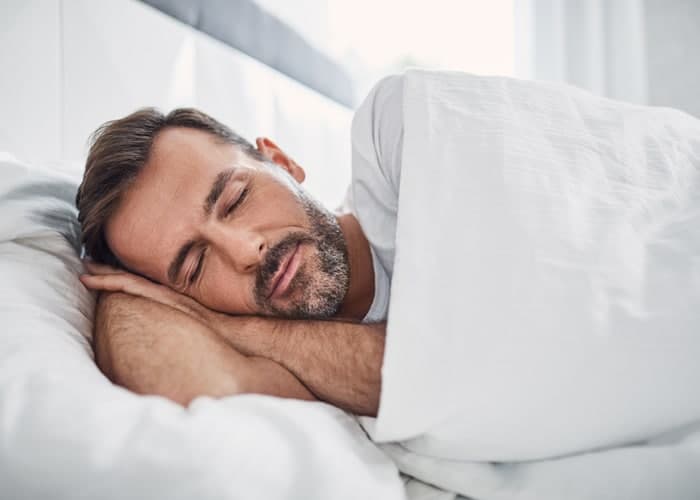Bed partners of snorers often master the old trick of using an elbow to encourage rolling over. I’ve even heard someone joke that their only sleep problem is waking up with bruised ribs. Old Trick and jokes always have a hint of truth, and these are no different. Sleep tests monitor position in addition to breathing and snoring, and studies show that snoring and sleep apnea is worse when lying on the back for the majority of people tested.
Snoring is often associated with obstructive sleep apnea because both occur when tissue begins to close off the airway. When the tissue begins to fall into the airway, it vibrates causing the snoring noise. When it completed closes or obstructs the airway, breathing stops until the “fight or flight” response kicks in to take a breath. This is called obstructive sleep apnea (OSA), and for many adults this happens multiple times an hour all night long.
Heavy snoring is a common sign of OSA and even those that “just snore” now will likely develop into full sleep apnea in the future. To properly diagnose snoring versus OSA, a sleep test is needed, but be sure the test includes position. All in-lab sleep tests monitor position, and most home sleep tests do too. The sleep test results will show when apneas occur in supine (lying on the back), side, or prone, and if there is a significant difference then treatment could include a positioning device.
What is a Positioning device?
Positional therapy is treating by preventing a patient from sleeping in the worst sleeping position, usually on their back. The most common method is a “pillow” that straps on the back and gently keeps a person sleeping on their side, such as the Zzoma available from Sleep Impressions. There is a more advanced electronic device from Philips that senses body position and makes a slight vibration when a person rolls on to their back to train side sleeping. There are less advanced methods also, such as putting a tennis ball inside the back of a shirt, but no data is available on that.
When is a Positioning device effective?
Positioning devices can be helpful in for almost anyone with Obstructive Sleep Apnea or Snoring because it can be used when apneas are entirely positional, in combination with other apnea treatment, or for just snoring.
Positional Sleep Apnea is when the majority of apneas occur in the supine position (defined as AHI in supine at least twice the AHI in non-supine). In those cases, a physician may suggest treating with a positioning device. Numerous research studies have shown positioning device reduce the number of apneic events by 40-50%. While positional therapy is not widely recognized as primary treatment, some physicians are recommending it for mild cases of positional sleep apnea and seeing the benefits. Dr. Joseph Berkowski, MD, sleep specialist at the Michigan Medicine Sleep Clinic, effectively treats 5% of his sleep apnea patients with just positional therapy.
OSA Combination Treatment is when a positional device is used in additional to another treatment for sleep apnea, such as CPAP or oral appliance. While controlling sleep position reduces the number of apneas, it is not as effective in eliminating apnea as CPAP, especially for moderate and severe sleep apnea. However, if a pillow or similar device is used to reduce the number of apneas in conjunction with another treatment, the combination is more effective and more comfortable. When positional treatment is used with a CPAP, research shows the average CPAP pressure needed to eliminate apneas is significantly less. And lower pressures are easier to tolerate and wear through the night. When used with an oral appliance or mandibular advancement device (MAD), the number of apneas and hypopneas is reduced even more than with an oral appliance alone. MAD and positional devices are reported by patient to be more comfortable than CPAP and have a high compliance or usage rate.
Snoring Prevention is also a benefit of a positioning pillow when sleep test results are negative for sleep apnea. This means that the airway tissue is relaxed and beginning to fall into the airway, but doesn’t completely collapse causing apneas. It is still disrupting your sleep, and your bed partner’s too! One study found that using a positioning pillow for at least 4 hours a night reduced snoring 47% – meaning the # of breaths with a loud snoring sound each hour dropped significantly.
Positioning Devices are readily available
Positioning devices are an effective therapy to reduce occurrences of apnea and to treat snoring. It is one of the few treatment options that can help everyone that gets tested for sleep apnea – from severe cases where positioning minimizes apneas so that the primary treatment is more effective to cases with just snoring where it can be the only treatment. If you have had a sleep test, review your results to see where you fall in that range. Wherever you are, consider trying a positioning device. Sleep Impressions has researched the pillows on the market and recommends a couple that are readily available on Amazon.
https://www.ncbi.nlm.nih.gov/pmc/articles/PMC3575552/
https://pubmed.ncbi.nlm.nih.gov/10531165/
https://www.ncbi.nlm.nih.gov/pmc/articles/PMC4676069/
https://www.sleepreviewmag.com/sleep-treatments/therapy-devices/positional-therapies-supine/why-prescribe-positional-obstructive-sleep-apnea-therapies/
